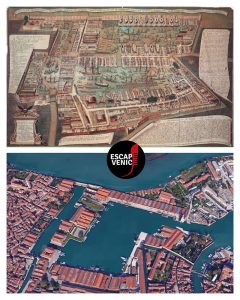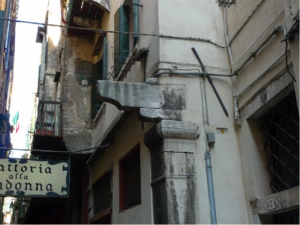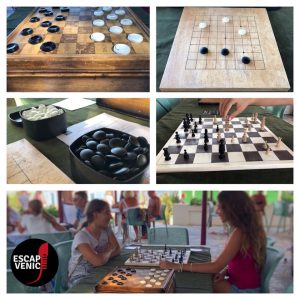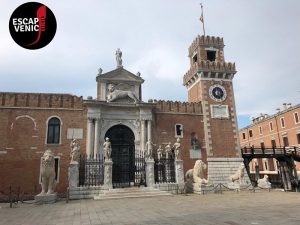
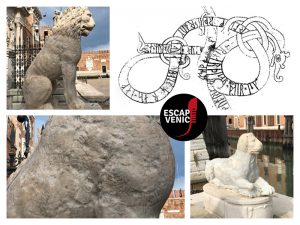
THE ARSENAL OF VENICE AND THE LEGEND OF THE LIONS
The Venice Arsenal was a fundamental place for the life of the city. It was a real city in the city. It was the place that allowed Venice to dominate the seas militarily and commercially. At the military entrance to the Arsenal there are 4 lions (not one!) to symbolize the importance of the place. Such a place is rich in legends. One of them tells the story of the lions guarding the entrance.
The biggest lions are spoils of war and come from Athens and carry engraved runic inscriptions. One of the two youngest came from Delos, in memory of Corfu’s victory in 1718.
Legend is full of magic! The protagonists are a magician, a hero and lions… if you’re ready to listen, you’ll hear the story.
Legend has it that in November 1719, after a storm that had lasted a couple of days, the horribly torn bodies of two sailors, one Greek and the other Maltese, were found right next to the Arsenal portal… they seemed to have been torn apart by a beast.
The authorities tried to know if by any chance some beast had escaped from some menagerie, but nothing. People were afraid and they started talking about magic, the lions of the Arsenal, the place. The surveillance of the area was entrusted to the Navy (which still supervises the area) and Captain Enrico Giustinian.
After about a week another stormy night, and a new body horribly torn apart, that of such Jacopo Zanchi, a sort of perdiday, unreliable person like his wife, prostitute for lost time.
All the victims lived not far from the place where they were found, and this other event increased terror among the local residents.
One day Captain Enrico Giustinian saw a scene in the street between Zanchi’s widow and an old merchant with a reputation for usurer, called Foscaro. The widow was insulting the usurer who sibilated to her “We’ll see where your boldness ends on the next stormy night”.
On the next stormy night Captain Giustinian hid near the entrance to the Arsenal and waited to be guarded by his sword. The hours passed and finally, between midnight and one o’clock, always under the pouring rain and the wind, an arch of fire arrived from the nearby houses and literally materialized the old Foscaro near the greatest lions. He revolved around one of them, touching the runic inscription with his fingers and at the same time pronouncing its meaning in this mysterious language. At that moment a luminous globe was formed on the portal and a first lightning struck the seated lion that slowly took life, huge and fierce.
Just at that moment Zanchi’s widow, accompanied by a friend, turned the corner of the shore and, while a second globe with a second lightning struck the other lion, the first was already fiercely resetting one of the two women.
The old usurer watched the scene, impassively, continuing to pronounce mysterious words and touching the runes. Shaken by terror and magic sings, the Captain splashed the sword and struck the old man in his chest, just as a third lightning struck the third lion.
With a frightening roar and blinding flash of lightning everything returned instantly as before: the lions in their place, motionless, the friend of the widow, mortar crumbled immersed in her blood. Of the old man remained only a heart of stone next to the sword that had fallen on the chews.
The head of the third lion was still alive, and roaring and moving desperately anchored as it was to a body of stone, so the Giustinian beheaded him. The head did not fall down but exploded literally, spreading around a blackish substance.
Subsequent investigations showed that the old man was a sorcerer and had been cheated by Zanchi, so he wanted to take revenge. The widow was locked up in the asylum, because she had gone mad, and the head of the third lion was replaced, as can still be seen today.
Legend perhaps is linked to some element of truth in fact if you go to the arsenal observe the great lion on the left of the entrance, and look for the runes, they are still there. Then go and see the third lion, towards the canal… the head is of a different colour!
True or not true this legend is still suggestive and the mystery is still imbued in this fantastic place, rich in ancient elements and perhaps (for those who believe) magical.
This is Venice rich in mystery and magic in many corners of the city. His legends can see, touch and perhaps, closing their eyes, relive in a sort of journey through space and time!

